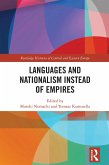Dieser Download kann aus rechtlichen Gründen nur mit Rechnungsadresse in A, B, BG, CY, CZ, D, DK, EW, E, FIN, F, GR, HR, H, IRL, I, LT, L, LR, M, NL, PL, P, R, S, SLO, SK ausgeliefert werden.
"Kamusella's latest work supplies the reader with an impressive array of historical information on a great number of lects and is highly ambitious in its aim to cover the linguistic developments in Central Europe during the last millennium. ... this book makes a valuable contribution to an important field of study. ... very useful reading for, say, specialists in one Central European lect who wish to learn more about the broader Central European picture." (Gesine Argent, Journal of Historical Sociolinguistics, Vol. 2 (1), 2016)









